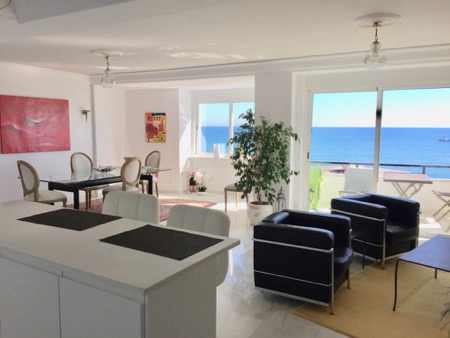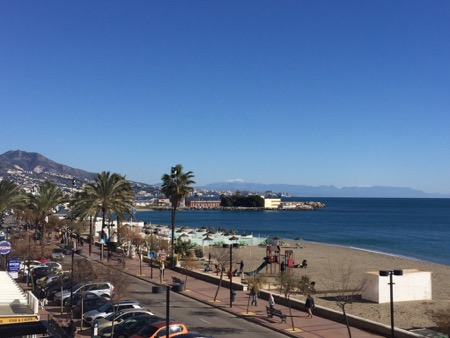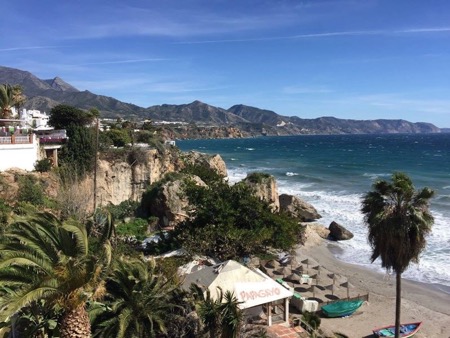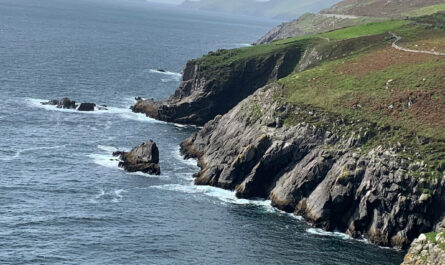Yes, winter can be fun … when you’re young. When you’re older, not so much. The places we Canadians typically head off to have lovely weather, and most are even driveable. So, quite adequate if you simply want to get out of winter. However, if you are looking for something a little more interesting, and a richer travel experience, you could consider the Costa del Sol region in Southern Spain.
When we retired, we did head south to Florida for a couple of years, but that soon began to wear thin. Although we were sold on escaping winter, we weren’t married to the idea of going to Florida every year. Having some experience as world travelers, we thought we would give another international locale a try. The fact that the Love-goddess refuses to set foot in America until they have a new President had absolutely nothing to do with it.
We considered going to the Algarve region in Portugal. We had heard good things about it from other Canadians who had spent time there. But, I proposed Spain as an alternative, simply based on the fact that the language would be easier to learn.
After a little bit of research, we decided to try out the city of Cadiz, not far from the Algarve region. Prior to making firm plans our minds got changed. We were riding on a train from Madrid to Seville one day and a Spanish woman we were chatting with told us that Marbella was the place we needed to go to, not Cadiz. We took her advice, and Marbella on the Costa del Sol it was.
As I write this, we are currently living on the Costa for February and March for the third year in a row. We are sold on the area. This year we are trying out the city of Fuengirola, having already tried Marbella and Nerja. We agreed that it would be best to try out a number of towns before choosing one to stick with.
So, here it is. My list of reasons for considering the Costa del Sol for your winter getaway.
The Costa del Sol is squeezed in between the Mediterranean and a number of beautiful mountain ranges stretching up and down the coast. This photo is the view from where we are renting this winter. Enough said!
If you are into beaches, every town along the coast has numerous, beautiful sand beaches. And yes, some people do swim in February. More so in March, of course.
2) It’s the Off Season
The Costa is a major European vacation destination in the summer, but it is considerably less busy in the winter. A great deal of the rental accommodation that is available to handle the incredible summer demand is siting empty in the winter. Yes, many folks from northern Europe are still coming down here for a break from winter, but in lower numbers.
Because it is a tourist area, lots of amenities and services are available. There are local transportation systems between the towns and villages, many modern grocery stores, shopping malls if you are into that, organized tours, tourist information offices, and a wide range of restaurants at a variety of price points.
3) Accommodation is Relatively Inexpensive
I am providing links and pricing to the places we have rented in the three years we have been coming here. This will give you an idea of the cost involved.
If you are wondering, the places we have been renting are at the high end of the middle range. Certainly less expensive places can be had. And, there are luxury places available if you have big bucks to spend. To give you a sense of the cost in a relative sense, we were paying $4,000 US (5,400 CAD) per month in Florida when we last stayed there.
2019 Fuengirola – February & March – 1,500€ per month (~$2,400 CAD)
(~$2,400 CAD)
The unit was advertised as a two-bedroom place; before we arrived, it was converted back to the original three-bedroom floor plan. This puts the kitchen nicely in the living area. It looked great in the online photos and looks even better in real life, and it sits right on the beach. We arranged it through a Spain-only AirBnB equivalent.
https://www.spain-holiday.com/18663
2018 Nerja – February – 1,150€ per month (~$1,500 CAD)
Great two-bedroom unit in a complex right on the Mediterranean. Our unit was at the back of the building, so we had a view of the water, but not as spectacular as this year. We arranged this through a local realty company, which is how most of the rentals in the Costa del Soll are conducted.
https://www.teamstarholidayrentals.com/rentals/apartment-nerja-r9912-las-fuentes-223955.html
2017 Marbella – February & March – $3,000 CAD per month
Nice two-bedroom, about a 10-minute walk from the waterfront. Being our first attempt at renting, we overpaid. And, to put it kindly, the host was “not ideal”; e.g. had failed to pay the electricity bill! :-O
https://www.airbnb.ca/rooms/4954754?guests=1&adults=1
4) Weather
The climate in winter is moderate. The average daily high in February is 18 degrees, and in March it is 19. That said, even though it is early February we have already experienced days when the temperatures are in the 20s. It’s called Costa del Sol (Sun Coast) for a very good reason … many, many sunny days. These tend to make one feel even warmer than the weather forecast suggests.
5) Cost of Living is Generally Low
Europe can be very expensive, but there are regional variations. In my experience, the cost of most things seems to decrease as you go further south. The net result is that both Portugal and Spain are comparatively inexpensive. This is especially true with the categories of goods and services that we Snowbirds would be purchasing. Things like; food, transportation, and beer and wine are mostly cheaper than at home. By way of example, we buy great wines here in the 3.00-6:00€ range. Converting to Canadian dollars that is approximately $4.50-$9.00. There are many others that cost less.
If you would like to compare food prices, here are links to the weekly flyers that a couple of the supermarkets we frequent put out. To convert Euros to $CAD the easiest conversion is to add 50% e.g. 2€ = 2 + 1 = $3.00CAD. Pricing on meats, fruits, and vegetables is per Kilogram (2.2 lbs), and “2a unidad – 70%” means the second unit is reduced by 70%.
SuperSol: http://en.supersol.es (page is in English; flyer is not) If you need to type in a city name, use “Fuengirola”)
Carrefour: https://folleto.carrefour.es/Carrefour-Fuengirola/63534 (sorry, no English; just click on the various flyers; it’s the pictures and pricing that are important)
The availability of low-cost food is important, but not as essential as selection, freshness, and taste! The Love-goddess and I are convinced that the quality and flavours of the food here are noticeably better than at home.
The Costa is a major market garden area, so there are always lots of fresh vegetables and fruit on the shelves. The oranges are amazing! If you love seafood and fish, this is the place to be. It is not impossible for the calamari you are eating for dinner to have been swimming in the Mediterranean that morning.
I spoke about western style groceries stores above. That was primarily to show you that when you get here you can shop in exactly the same manner as you do at home. However, the region is awash in markets and fruit and vegetable stands for the more adventurous. The market in this photo is in Malaga, and is one of my favourite in Europe.
7) Culture & History
The Costa is in the Andalucía Region of Spain. Andalucía has an incredibly rich history, and has made many important cultural contributions to Spanish culture (Flamenco dance and music, Picasso, The Alhambra, bullfighting … okay, maybe bullfighting’s not such a great contribution). And, you can experience them all here on the Costa. You can read a brief overview about the region on Wikipedia (https://en.wikipedia.org/wiki/Andalusia ).
As you will have read in the Wikipedia article, this area was the last to fall in the Reconquista ending the 700+ year Moorish rule. As a result, many of the great local Moorish sites have been preserved and are open to the public. Many Roman sites can be found as well.
 8) Interesting Places to Visit, and How to Get There
8) Interesting Places to Visit, and How to Get There
All of the cities and towns along the Costa (Malaga, Torremolinos, Fuengirolla, Nerja, etc.) are very easy to get to. Additionally, there are an amazing number of cities and towns close enough for day trips or overnight expeditions; Granada, Seville, Gibraltar, Cordoba, and the many hill-towns (Pueblo Blanco) like Ronda.
Most, if not all, of these places are accessible by bus. There are two different bus services in Spain. ALSA (https://www.alsa.com/en/web/bus/home#) covers the routes between major cities, and Avanza (https://booking.avanzabus.com/web/index.php?lang=en), which covers the more local routes. Both offer senior rates (60+).
Alternatively, if you don’t mind driving, or prefer getting yourself around, you can easily rent a car and get to these same places, or further afield, within a few short hours. An excellent four-lane highway system services most of these places. By way of example, two years ago we drove from Marbella to Tavira in the Algarve region in Portugal and the trip took just over four hours, Gibraltar was an hour’s drive.
Driving times from Fuengirola, according to Google Maps:
Granada – 1 hour 43 minutes
Seville – 2 hours 25 minutes
Cordoba – 1 hour and 57 minutes
Gibraltar – 1 hour 25 minutes
Jerez – 2 hour 9 minutes
Ronda – 1 hour 25 minutes
Tavira, Portugal – 4 hours 7 minutes
You can even do day trips to Tangier, Morocco with a tour company if you want. But, be warned, it is a shopping trip; even though you won’t realise that until you get there. That said, it is fun to be able to say that you stepped onto another continent.
The choices of locations and the types of living experiences available are as varied as people’s personal preferences. A good fit, just for you, can be found. You can live in a beach town with lots of expats around, or in a Spanish village in the close-by hills and be deeply immersed in Spanish culture and language. The photo to the left is the waterfront in the town of Nerja. As you can see, the coast is much more rugged up there.
10) Language
Generally, language differences provide only a minor issue. Over 300,000 Brits live in Spain full time, and many of them are in the Costa area. The net result is many places of business have some staff who speak English, and most restaurants now offer multi-language menus. However, it is always good to be able to thank people or ask a couple of simple, important questions in Spanish (e.g. Where are the toilets?)
11) Cell Phones
One of the things I love about Europe in general is how easy it is to pick up a SIM for your phone and have a local number and Internet service. A wide range of providers are available in the EU (e.g. Orange, Movistar, O2, Lycamobile), all offering inexpensive pay-as-you-go plans.
This year we picked up SIMs from Orange. We are paying 20€ per month, which includes 80 minutes of calls in Spain, and 10 GB of data. And, it is as simple as handing over a 20€ bill and you are in business. It’s not 20€ plus, plus. You do need to have your passport with you when you go into a store to sign up.
12) Golf
A large number of beautiful golf courses can be found all up and down the coast. Sadly, they tend to be expensive (~$100 CAD per round), so I have never brought my clubs. Although the Costa is primarily a summer destination for holidayers looking for some beach time, it is a favourite winter destination for golfers. Apparently, it has the highest concentration of courses in all of Europe. One of the many nicknames for the area is Costa del Golf.
Most people fly in; Malaga is the major air hub in the region. AirTransat is the only Canadian airline that flies to Malaga directly. It offers flights from Toronto and Montreal. Other than that, you will need to make a connecting flight at some other European city. There are flights from most major city’s airports to Malaga.
However, if you want to approach things a little differently you can make the coming and going a little more adventurous by visiting other stops as part of your trip – especially if you are willing to book with European airlines.
Two years ago, we routed through Dublin using Aer Lingus. We hung out in Dublin on the way, and then travelled outside the city a bit on our way home. Last year we flew TAP to Lisbon, and then caught a short commuter flight to Malaga. We had a great time exploring Lisbon on the way, and had an even better time going up to Porto on the way home.
This year we flew Air Canada to Madrid and took the train down to Malaga. The Spanish train system Renfe (http://www.renfe.com/EN/viajeros/index.html) offers a special senior pass, the “Tarjeta Dorada”, that allows users to buy tickets at up to 40% off. Madrid is yet another great European city worth spending time in. To give you an idea about air travel costs, we paid $1855.28 for two return flights to Madrid, i.e. $927.64 each.
There you have it!
At very least, I hope I have you thinking that changing up where you winter might be something worth considering.









Thank You for your article, we are from Ottawa and plan to retire next year. Would like to get away in the the winter months. Thank You for sharing.
Just read your article and very helpful because we are considering Spain in winter from Canada. What town have you enjoyed the most of the three you have stayed? Have you ever considered staying in Malaga or do you prefer smaller cities? Thanks so much, Lily
Just came across your article, thanks for sharing!
We are from Toronto and are planning to be on Spain for 3 months starting January.
Great tricks and tips, thanks again.
Nicely written Greg and I agree with the concept of mixing it up for your winter breaks. Keep on blogging!